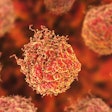
An artificial intelligence (AI) algorithm was able to rapidly detect, grade, and quantify prostate cancer on pathology slides highly accurately and efficiently, with significantly reduced interobserver variability, according to research published November 3 in JAMA Network Open.
The study suggests that AI has the potential to transform histopathological evaluation and optimize the risk stratification and clinical management of prostate cancer, giving it more of a precision approach, according to the study's authors, from the University of Wisconsin and elsewhere.
The investigators chronologically selected 589 men with biopsy-confirmed prostate cancer who received care in the University of Wisconsin Health System between January 2005 and February 2017. They scanned 1,000 biopsy slides -- one or two slides per patient -- to create digital whole-slide images, from which they developed and validated a deep convolutional neural network-based AI-powered platform.
The whole-slide images were divided into a training set and validation set. Three experienced academic urological pathologists were involved in the validation, according to the researchers.
Generally, one representative slide was selected from each patient if it contained the representative prostate cancer, Gleason patterns, and benign glands. For some patients, two slides were selected. A total of 1,000 formalin-fixed, paraffin-embedded, hematoxylin-eosin-stained prostate biopsy slides were included.
The investigators used a high-capacity scanner at 40X magnification to create whole-slide images, which were divided into a training set for algorithm and model development and a validation set. The validation set included a mixture of all Gleason patterns and prostate cancer Gleason grade groups. The algorithm was validated by the three pathologists independently using the validation set of whole-slide images.
The AI algorithm, based on deep convolutional neural network models and hybrid architectures, distinguished prostate cancer from benign prostatic epithelium and stroma with high accuracy at the image patch-pixel level. Using the validation set of whole-slide images, the AI system detected cancer in all cores among all cases at the slide level.
AI achieved almost perfect agreement with the training pathologist in detecting prostate cancer at the patch-pixel level, and in grading prostate cancer at the slide level. It could identify different Gleason patterns with high accuracy at the patch-pixel level, the scientists reported.
"Use of the AI-assisted method was associated with significant improvements in the concordance of prostate cancer grading and quantification between the three pathologists," wrote Dr. Wei Huang and colleagues.
Notably, it took the three pathologists about four to six minutes per slide to manually complete grading and quantification and to generate a diagnosis, while they generally spent less than one minute to finish the same tasks using AI.
The AI-powered platform segmented and labeled each cancer gland or epithelial patch with a corresponding Gleason pattern on the tissue, then totaled those values to generate the Gleason pattern volumes, Gleason score, and prostate cancer volume.
"On rare occasions, a low-volume prostate cancer diagnosis was missed by pathologists during manual grading. However, no diagnoses were missed using the AI-assisted method," the researchers wrote. Actually, the data revealed a significantly higher number of 100% consensus in grading -- cases for which all pathologists agreed -- using the AI-assisted technique.
The Gleason grading system has been the most reliable tool for predicting prostate cancer. However, its usefulness in the clinical setting is limited by interobserver variability in grading and quantification, which has negative consequences for risk assessment and clinical management of prostate cancer, the scientists noted.
Manual diagnosis, grading, and quantification of prostate cancer are subjective, with substantial interobserver variability, even among practicing pathologists who are prostate cancer experts. There is therefore an unmet need for an unbiased decision support tool that can improve the reproducibility of Gleason grading and quantification on a unified platform during routine clinical practice.
Applying AI to cancer detection, grading, and quantification, including the use of deep convolutional neural networks to evaluate tissue samples, has become more realistic, thanks to digital whole-slide imaging and computational methodologies for pathological evaluation.



















